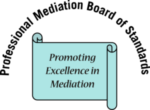FAQ
Most frequent questions and answers
a) Because these paths are not paths that were designed by professional family mediators. The paths were mostly designed by Courts, the bar or other governmental entities to allow already credentialed professionals (mainly members of the bar) to hold themselves out to the public as competent, state certified mediators, in addition to their being certified in their profession of origin.
b) Because these paths for certification of mediators have not required sufficient levels of training, experience and supervision, they, most generally, require only 30-40 hours of basic mediation training to become certified, which is not enough to teach and learn all that is required of becoming a professional family mediator.
c) Most importantly, they can be seen as an opportunity for lawyers to expand their practices to take advantage of some of the mediation market that has been created. Persons wishing to hold themselves out to the public as mediators can now hold themselves out as “State Certified or Supreme Court Qualified” However,
1) Those lists serve the needs of the court system, not the public.
2) Some of those lists exclude behavioral science professionals such as Rule 8.9 Roster of Alternative Dispute Resolutions Neutrals, North Dakota State Supreme Court Rules which says: “4) Post-Judgment Domestic Relations Mediator Roster. A domestic relations proceedings mediator shall complete 40 hours minimum of domestic relations mediation training, including two hours minimum of domestic abuse training, and nine hours of continued domestic relations mediation training during each three-year period, and have a license to practice law supplemented with two years of experience in domestic relations.” If one does not possess a license to practice law, they are not considered for qualifying as a domestic relations mediator.
Unfortunately, they have gotten it completely wrong. They are expanding the use and development of, not mediation, but adjudicative processes which they call mediation. These list makers most often confuse mediation with settlement conferencing, neutral evaluation or some other coercive, adjudicative procedure under the guise of mediation. For example, consider a statement on the Dakota County Website (Minnesota) describing mediation resources for the public:
- Mediation
Mediation can help resolve issues with a spouse during the divorce process. To learn more, read about Early Neutral Evaluation.
Please click the above link which is reproduced exactly as it appears at
https://www.co.dakota.mn.us/LawJustice/LawLibrary/ResourceTopics/Pages/divorce.aspx
- Unfortunately, these other flowers are not models but rather versions of adjudicative practice.
- It could possibly be argued that in some fields, the proliferation of various versions of ADR is a good thing, but that observation only works in established fields such as psychology for example, which has had many years of professional development enabling it to define itself over a long period of time. A healthy debate between the behaviorists, the humanists, the cognitive therapists or the psychotherapists is seen as good for the field. Such a view is not good for mediation because:
- Mediation is not yet a developed field like psychology (although it can be argued that mediation credentialing faces the same challenges as were faced by the early psychologists).
- Mediation is quite different, because (unlike psychology which did not early on face a competing industry of mind researchers) mediation faces a parallel competing industry of conflict resolvers who employ a competitive approach to conflict resolution and who wish to maintain a monopoly on the business of conflict resolution for a fee.
- Because Family Mediation is still emerging and defining itself as a profession, a variety of versions have actually hindered the development of the profession of family mediation and confused the public by creating the notion that anything that pertains to conflict resolution (either cooperative or competitive processes) can be called mediation. This has resulted in a variety of conflict resolution procedures being passed off as mediation, when they are in fact coercive, adjudicative models which they call mediation. Examples are ENE (early neutral evaluation), directive mediation, evaluative mediation, med-arb, cooperative law, collaborative law, and mediation advocacy.”
- In the end, the hundred flowers approach is confusing to a public who does not know what process they are submitting to. This approach has inhibited the growth of mediation, because there is no clear definition of what constitutes effective professional family mediation in these approaches. There is no adherence to the Standards of Practice for Family Mediators which is accepted by the ABA, ACR and the APFM. Therefore, if the Standards of Practice for Family Mediators are not uniformly followed, it is difficult to measure its practitioners for competency. Credentialing will solve these problems and redirect the negative one-way influences the adversarial system has had on mediation. It will accomplish this by its adherence to the Standards of Practice for Family Mediators as the basis for best practices and professionalism in the field. The article by Marvin Johnson and Stephen Erickson titled: ADR Techniques and Procedures Flowing Through Porous Boundaries: Flooding the ADR Landscapes and Confusing the Public, “addresses this growing trend in ADR—the blurring of boundaries between various ADR processes. This blurring of boundaries raises crucial issues to the further development of the field, particularly regarding fundamental distinctions between ADR processes that encourage cooperative behavior versus those that encourage competitive behavior…The intention of this article is to raise questions designed to clarify more principled boundaries between various ADR processes in order to assist the public and the practitioner to understand truly what the profession is offering and to protect consumer choice. The authors set forth what they believe are principled boundary distinctions between more client-centered cooperative ADR processes and more legally focused, adjudicative, competitive ADR processes to enable parties to understand the fundamental principles guiding each approach and to make better choices about which approach will better meet their goals in particular cases.” (Full article available from Steve Erickson, Erickson Mediation Institute ericksonmediation.com or Marvin Johnson www.natlctr4adr.org)
- Many say credentialing is needed to protect the public. That is an important goal, and we must help the public be informed about the process it is receiving or purchasing.
- The Standards of Practice for Family Mediators defines the field of mediation as a process that is:
- Non-coercive
- Respectful of self-determination
- Client centered and not law-centered, not diagnostic-centered, not behavioral-pathology centered, not therapy centered, not relational transforming centered.
- Self-Empowering engaged in by people who are competent to make intelligent decisions for themselves if given proper guidance, assistance, education, and encouragement.
- The preferred process of conflict resolution for families and children.
- The process that has been practiced for 46 years, and experienced extensive research resulting in supporting it as a unique profession.
We are also trying to create a credentialing process that will:
- Provide the public with information in order to make an informed choice about which dispute resolution process they wish to choose to engage in.
- Partner with existing family focused mediation organizations that have made courageous initial efforts at credentialing.
- Enhance the professionalism of the field such that one may not simply choose to call themselves a “certified on a particular list” mediator when advertising to the public, but must first attain a level of skill and professionalism to be able to hold oneself out to the public as a credentialed “Professional Family Mediator.”
- Prevent mediation from becoming a backwater sub-specialty of the practice of law.
- Prevent the public from being misled about what constitutes best practices as a mediator.
- Discourage marketing approaches that label a prospective professional mediator as a “Retired Judge Mediator,” “Therapist Mediator,” “Early Neutral Evaluative Mediator,” or “Lawyer Mediator” because they are misleading to the public and combine two distinctly different professions. Moreover, such merging of the two professions raises serious questions about which ethical standards should be followed in a given case.
The field has learned a lot about itself since the early 1980’s when the original Family Mediation Association and the Academy of Family Mediators was formed. The successor organization, the Academy of Professional Family Mediators has developed thoughtful and rigorous Standards of Practice based upon the experience of thousands of family mediators since 1974. These standards are reproduced at this web site, and they serve as a solid platform to go forward with credentialing.
- Under ICE (the Institute for Credentialing Excellence) procedures, subject matter experts familiar with these Standards of Practice will be chosen to help further refine and develop criteria for determining professional excellence and mediator qualifications.
- An important principle behind developing criteria for measuring professional excellence is the foundational belief that professional family mediators are client centered, not coercive in their work, and respectful of the participant’s self determination. This concept will hopefully embrace many models and approaches to family mediation, but it will not credential any person who employs a process of mediation that is adjudicative or predictive of outcomes in court.
- This depends on what value is perceived. For the professional family mediator, this credentialing legitimizes the practice of family mediation as valid, reliable, and legally defensible.
- Estimates are that to accomplish a legally process using ICE (Institute for Credentialing Excellence) and NCCA (National Commission for Certification Services) requirements would cost in the neighborhood of $300,000.
- Before the old Academy of Family Mediators merged with SPIDR (THE SOCIETY OF PROFESSIONALS IN DISPUTE RESOLUTION) and CRENET (CONFLICT RESOLUTION EDUCATION NETWORK) in 2001, it had over 4,000 family mediation members, and the field was vibrant and expanding. Credentialing would revitalize the field by establishing industry standards (as professionalized by ICE) that many would find useful for their own professional standing in the community if a certification process were available.
- There is a reason people seek certification: it defines and legitimizes the profession of family mediation. Below is a list of just a few of the occupations that have recently taken the time and spent the money to obtain credentialing authority from ICE and NCCA:
- Certified Personal Trainer
- Certified Wound Care Associate
- Certified Retirement Counselor
- Certified Irrigation Contractor
- Certified Valuation Analyst
- Certified Paralegal
- Certified Professional Dog Care Trainer
- Certified Culinary Educator
- Certified Addiction Treatment Counselor
There are many other occupations that have sought credentialing under the auspices of ICE and NCCA. For a complete listing, please see their web site at www.credentialingexcellence.org
The time to complete this work is now. Won’t you join with us in this important effort and contribute $100 or $500 or whatever you can to this effort? The Professional Mediation Board of Standards is a 501 (c) (3) not for profit corporation organized under the laws of the State of Minnesota and your donation is tax deductible.


